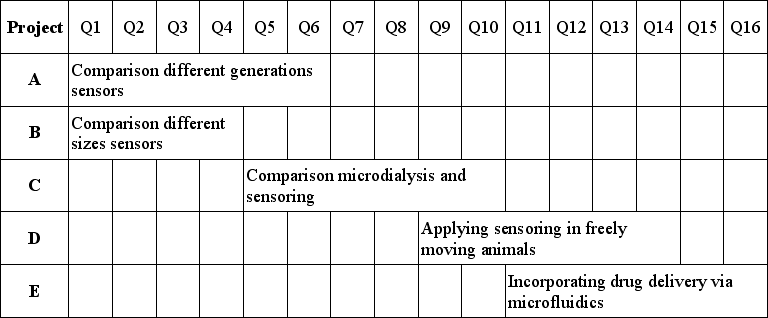Microdialysis is an established method to determine extracellular levels of transmitters and metabolites in the brain. Microsensors represent a recently introduced alternative with increased temporal and spatial resolution.
Prior PhD projects have focused on the construction and validation of a glutamate sensor of the 2nd generation (Oldenziel et al, 2005 and 2005). The present PhD project will focus on addressing several issues;
b. Do different dimensions of microsensors yield different data? The general consensus on microsensors is that they pick up more neuronally derived glutamate compared to microdialysis because they induce less damage during insertion due to their decreased size. Microsensors of the Gerhard type are similar in size compared to a microdialysis probe, yet these sensors show a degree of TTX dependency (hence reflect neuronally derived glutamate). Apparently, a discrepancy exists with microdialysis data where no TTX dependency is observed. Sensors of several sizes will be compared with respect to its TTX dependency.
c. Do microdialysis and microsensors sample the same pool? To answer this question several pharmacological interventions will be studied in vivo in order to obtain information as to whether pharmacological responses differ between microdialysis and sensoring. In addition, quantitative microdialysis will be employed to be able to compare absolute levels of glutamate as quantified using sensoring and microdialysis.
d. Can the microsensor be applied to freely moving design? Current sensoring experiments are performed under anaesthesia. Performing experiments in freely moving animals increases the relevance of data and field of application (eg behavioural experiments). To this end, the sensoring technique will be converted to yield a robust approach that can be employed in freely moving animals. The construction of the sensor and its interface with amplifiers will need to be improved with respect to its sturdiness and overall design.
e. Can microfluidics be employed to apply drugs locally in the brain in the vicinity of the microsensor? Applying drugs locally at the site of measurement is a key issue in evaluating neurotransmitter interactions and general pharmacology. The construction of the microsensor needs to be converted so it can facilitate the application of drugs by means of microfluidics (channels of 100 microm).
-Sensoring (construction, in vitro and in vivo validation)
-Microdialysis (in vivo experiments)
-Analysis (LC-MS/MS for glutamate microdialysis experiments)
-Microfluidics (construction of drug application system incorporated in the sensor).

Prof Dr Ir B Westerink
Dr T Cremers
Dept. Biomonitoring and Sensoring
Institute of Pharmacy
University of Groningen
Antonius Deusinglaan 1
9713 AV
Netherlands
Email; t.i.f.h.cremers@rug.nl